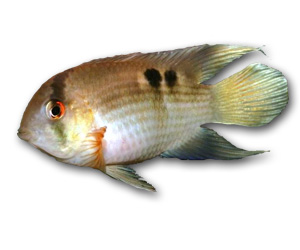Keyhole Cichlid

Quick Stats
| Size | 4.75" (12cm) |
|---|---|
| Tank | 120 litres + |
| Swimming Area | All |
| Ph | 6.8 to 8.0 |
| Temperature | 75ºF to 81ºF(25-30°C) |
| Food | Flaked, live and frozen foods |
Common Name:
Keyhole Cichlid
Distribution:
South America: Rio Orinoco basin, and rivers of Guyana.
Colouration:
The body has a mottled yellowish cream coloration, sometimes leaning toward brown. Occasionally the body is marked with faint lateral lines. A curved, dark band runs through the eye, from the front ray of the dorsal fin, down to the corner of the gill cover. The keyhole shaped marking, which the keyhole cichlid gets it's name from is located in the middle of the rear half of the fish. This marking may look like a keyhole or just a black dot.
Lifespan:
10 years +
Maintenance:
10 to 20% weekly water changes.
Feeding:
They will accept all types of food and relish anything live.
Substrate:
Sand.
Tank Decor:
The keyhole needs to feel secure in its tank, you should provide plenty of hiding places in the form of caves and driftwood. Plants are also helpful. The substrate should be fine gravel or sand and you should leave some open areas for swimming.
Filtration:
Provide good filtration and do frequent water changes. Not overly fond of strong currents.
Biotype:
Small creeks in the coastal zone, which have clear water and little current.
Breeding:
They can be one easier cichlids to breed, and have even bred in community tanks. Several young should be placed in your tank and allowed to pair off. They are open breeders, up to 300 eggs are deposited on a cleaned stone. The eggs are cared for by both parents, who will fan them with fresh water and pick out the unfertilized eggs. Many times a pair will eat their first brood, but they will spawn again in a matter of days. You can remove the eggs after they are laid if this continues and raise them in a separate tank.. The fry hatch after 3-5 days and are free-swimming several days later. Start feeding with roftiers and baby brine shrimp. The parents may continue their care for the fry for up to six months.